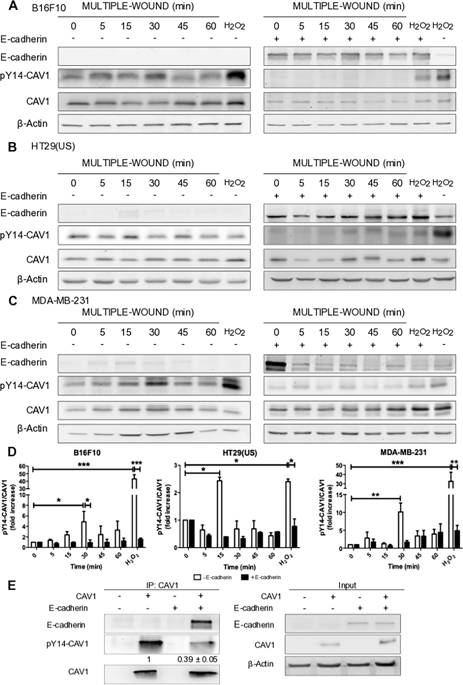Our official English website, www.x-mol.net, welcomes your
feedback! (Note: you will need to create a separate account there.)
The non-receptor tyrosine phosphatase type 14 blocks caveolin-1-enhanced cancer cell metastasis.
Oncogene ( IF 6.9 ) Pub Date : 2020-03-09 , DOI: 10.1038/s41388-020-1242-3 Natalia I Díaz-Valdivia 1 , Jorge Díaz 1, 2 , Pamela Contreras 1 , América Campos 1, 3 , Victoria Rojas-Celis 1 , Renato A Burgos-Ravanal 1 , Lorena Lobos-González 1, 3 , Vicente A Torres 2 , Viviana I Perez 4 , Balz Frei 4 , Lisette Leyton 1 , Andrew F G Quest 1
Oncogene ( IF 6.9 ) Pub Date : 2020-03-09 , DOI: 10.1038/s41388-020-1242-3 Natalia I Díaz-Valdivia 1 , Jorge Díaz 1, 2 , Pamela Contreras 1 , América Campos 1, 3 , Victoria Rojas-Celis 1 , Renato A Burgos-Ravanal 1 , Lorena Lobos-González 1, 3 , Vicente A Torres 2 , Viviana I Perez 4 , Balz Frei 4 , Lisette Leyton 1 , Andrew F G Quest 1
Affiliation

|
Caveolin-1 (CAV1) enhanced migration, invasion, and metastasis of cancer cells is inhibited by co-expression of the glycoprotein E-cadherin. Although the two proteins form a multiprotein complex that includes β-catenin, it remained unclear how this would contribute to blocking the metastasis promoting function of CAV1. Here, we characterized by mass spectrometry the protein composition of CAV1 immunoprecipitates from B16F10 murine melanoma cells expressing or not E-cadherin. The novel protein tyrosine phosphatase PTPN14 was identified by mass spectrometry analysis exclusively in co-immunoprecipitates of CAV1 with E-cadherin. Interestingly, PTPN14 is implicated in controlling metastasis, but only few known PTPN14 substrates exist. We corroborated by western blotting experiments that PTPN14 and CAV1 co-inmunoprecipitated in the presence of E-cadherin in B16F10 melanoma and other cancer cells. Moreover, the CAV1(Y14F) mutant protein was shown to co-immunoprecipitate with PTPN14 even in the absence of E-cadherin, and overexpression of PTPN14 reduced CAV1 phosphorylation on tyrosine-14, as well as suppressed CAV1-enhanced cell migration, invasion and Rac-1 activation in B16F10, metastatic colon [HT29(US)] and breast cancer (MDA-MB-231) cell lines. Finally, PTPN14 overexpression in B16F10 cells reduced the ability of CAV1 to induce metastasis in vivo. In summary, we identify here CAV1 as a novel substrate for PTPN14 and show that overexpression of this phosphatase suffices to reduce CAV1-induced metastasis.
中文翻译:

非受体酪氨酸磷酸酶 14 型可阻断 Caveolin-1 增强的癌细胞转移。
Caveolin-1 (CAV1) 增强癌细胞的迁移、侵袭和转移,但糖蛋白 E-钙粘蛋白的共表达会受到抑制。尽管这两种蛋白形成了包含 β-连环蛋白的多蛋白复合物,但仍不清楚这如何有助于阻断 CAV1 的转移促进功能。在这里,我们通过质谱分析了表达或不表达 E-钙粘蛋白的 B16F10 鼠黑色素瘤细胞中 CAV1 免疫沉淀物的蛋白质组成。通过质谱分析仅在 CAV1 与 E-钙粘蛋白的免疫共沉淀物中鉴定出新型蛋白酪氨酸磷酸酶 PTPN14。有趣的是,PTPN14 与控制转移有关,但已知的 PTPN14 底物很少。我们通过蛋白质印迹实验证实,在 B16F10 黑色素瘤和其他癌细胞中,在 E-钙粘蛋白存在的情况下,PTPN14 和 CAV1 发生共免疫沉淀。此外,即使在没有E-钙粘蛋白的情况下,CAV1(Y14F)突变蛋白也能与PTPN14共免疫沉淀,并且PTPN14的过表达降低了CAV1在酪氨酸14上的磷酸化,并抑制了CAV1增强的细胞迁移、侵袭和迁移。 B16F10、转移性结肠 [HT29(US)] 和乳腺癌 (MDA-MB-231) 细胞系中的 Rac-1 激活。最后,B16F10 细胞中 PTPN14 的过表达降低了 CAV1 诱导体内转移的能力。总之,我们在此将 CAV1 确定为 PTPN14 的新型底物,并表明这种磷酸酶的过度表达足以减少 CAV1 诱导的转移。即使在没有 E-钙粘蛋白的情况下,CAV1(Y14F) 突变蛋白也能与 PTPN14 共免疫沉淀,并且 PTPN14 的过表达会降低 CAV1 在 tyrosine-14 上的磷酸化,并抑制 CAV1 增强的细胞迁移、侵袭和 Rac- B16F10、转移性结肠 [HT29(US)] 和乳腺癌 (MDA-MB-231) 细胞系中的 1 激活。最后,B16F10 细胞中 PTPN14 的过表达降低了 CAV1 诱导体内转移的能力。总之,我们在此将 CAV1 确定为 PTPN14 的新型底物,并表明这种磷酸酶的过度表达足以减少 CAV1 诱导的转移。即使在没有 E-钙粘蛋白的情况下,CAV1(Y14F) 突变蛋白也能与 PTPN14 共免疫沉淀,并且 PTPN14 的过表达会降低 CAV1 在 tyrosine-14 上的磷酸化,并抑制 CAV1 增强的细胞迁移、侵袭和 Rac- B16F10、转移性结肠 [HT29(US)] 和乳腺癌 (MDA-MB-231) 细胞系中的 1 激活。最后,B16F10 细胞中 PTPN14 的过表达降低了 CAV1 诱导体内转移的能力。总之,我们在此将 CAV1 确定为 PTPN14 的新型底物,并表明这种磷酸酶的过度表达足以减少 CAV1 诱导的转移。B16F10、转移性结肠 [HT29(US)] 和乳腺癌 (MDA-MB-231) 细胞系中的侵袭和 Rac-1 激活。最后,B16F10 细胞中 PTPN14 的过表达降低了 CAV1 诱导体内转移的能力。总之,我们在此将 CAV1 确定为 PTPN14 的新型底物,并表明这种磷酸酶的过度表达足以减少 CAV1 诱导的转移。B16F10、转移性结肠 [HT29(US)] 和乳腺癌 (MDA-MB-231) 细胞系中的侵袭和 Rac-1 激活。最后,B16F10 细胞中 PTPN14 的过表达降低了 CAV1 诱导体内转移的能力。总之,我们在此将 CAV1 确定为 PTPN14 的新型底物,并表明这种磷酸酶的过度表达足以减少 CAV1 诱导的转移。
更新日期:2020-03-09
中文翻译:

非受体酪氨酸磷酸酶 14 型可阻断 Caveolin-1 增强的癌细胞转移。
Caveolin-1 (CAV1) 增强癌细胞的迁移、侵袭和转移,但糖蛋白 E-钙粘蛋白的共表达会受到抑制。尽管这两种蛋白形成了包含 β-连环蛋白的多蛋白复合物,但仍不清楚这如何有助于阻断 CAV1 的转移促进功能。在这里,我们通过质谱分析了表达或不表达 E-钙粘蛋白的 B16F10 鼠黑色素瘤细胞中 CAV1 免疫沉淀物的蛋白质组成。通过质谱分析仅在 CAV1 与 E-钙粘蛋白的免疫共沉淀物中鉴定出新型蛋白酪氨酸磷酸酶 PTPN14。有趣的是,PTPN14 与控制转移有关,但已知的 PTPN14 底物很少。我们通过蛋白质印迹实验证实,在 B16F10 黑色素瘤和其他癌细胞中,在 E-钙粘蛋白存在的情况下,PTPN14 和 CAV1 发生共免疫沉淀。此外,即使在没有E-钙粘蛋白的情况下,CAV1(Y14F)突变蛋白也能与PTPN14共免疫沉淀,并且PTPN14的过表达降低了CAV1在酪氨酸14上的磷酸化,并抑制了CAV1增强的细胞迁移、侵袭和迁移。 B16F10、转移性结肠 [HT29(US)] 和乳腺癌 (MDA-MB-231) 细胞系中的 Rac-1 激活。最后,B16F10 细胞中 PTPN14 的过表达降低了 CAV1 诱导体内转移的能力。总之,我们在此将 CAV1 确定为 PTPN14 的新型底物,并表明这种磷酸酶的过度表达足以减少 CAV1 诱导的转移。即使在没有 E-钙粘蛋白的情况下,CAV1(Y14F) 突变蛋白也能与 PTPN14 共免疫沉淀,并且 PTPN14 的过表达会降低 CAV1 在 tyrosine-14 上的磷酸化,并抑制 CAV1 增强的细胞迁移、侵袭和 Rac- B16F10、转移性结肠 [HT29(US)] 和乳腺癌 (MDA-MB-231) 细胞系中的 1 激活。最后,B16F10 细胞中 PTPN14 的过表达降低了 CAV1 诱导体内转移的能力。总之,我们在此将 CAV1 确定为 PTPN14 的新型底物,并表明这种磷酸酶的过度表达足以减少 CAV1 诱导的转移。即使在没有 E-钙粘蛋白的情况下,CAV1(Y14F) 突变蛋白也能与 PTPN14 共免疫沉淀,并且 PTPN14 的过表达会降低 CAV1 在 tyrosine-14 上的磷酸化,并抑制 CAV1 增强的细胞迁移、侵袭和 Rac- B16F10、转移性结肠 [HT29(US)] 和乳腺癌 (MDA-MB-231) 细胞系中的 1 激活。最后,B16F10 细胞中 PTPN14 的过表达降低了 CAV1 诱导体内转移的能力。总之,我们在此将 CAV1 确定为 PTPN14 的新型底物,并表明这种磷酸酶的过度表达足以减少 CAV1 诱导的转移。B16F10、转移性结肠 [HT29(US)] 和乳腺癌 (MDA-MB-231) 细胞系中的侵袭和 Rac-1 激活。最后,B16F10 细胞中 PTPN14 的过表达降低了 CAV1 诱导体内转移的能力。总之,我们在此将 CAV1 确定为 PTPN14 的新型底物,并表明这种磷酸酶的过度表达足以减少 CAV1 诱导的转移。B16F10、转移性结肠 [HT29(US)] 和乳腺癌 (MDA-MB-231) 细胞系中的侵袭和 Rac-1 激活。最后,B16F10 细胞中 PTPN14 的过表达降低了 CAV1 诱导体内转移的能力。总之,我们在此将 CAV1 确定为 PTPN14 的新型底物,并表明这种磷酸酶的过度表达足以减少 CAV1 诱导的转移。











































 京公网安备 11010802027423号
京公网安备 11010802027423号